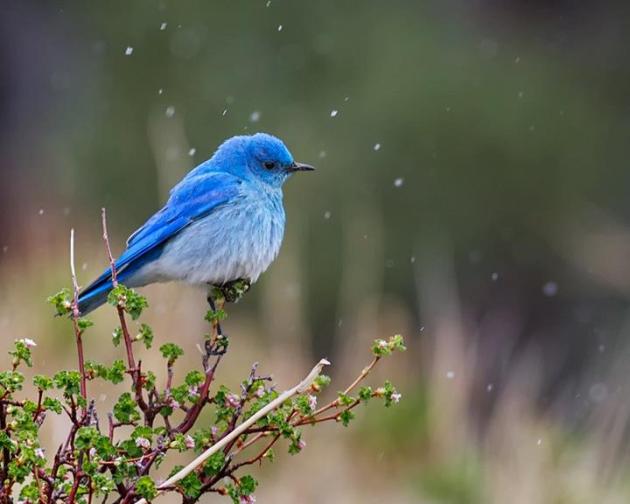The mountain bluebird (Sialia currucoides) is a bird that breeds on the high altitudes of southwestern United States, southeastern Alaska, and western Canada. It is a migratory species and spends winter season in the south. The bluebird has got long tail and wings. The mountain bluebird is a state bird of Nevada and Idaho.
Mountain Bluebird Facts
Anatomy
- Mountain bluebirds are small thrushes with long straight bill.
- The average length of the bird measures about 6.3–7.9 in (16–20 cm).
- Bluebirds weigh up to 30 g (1.1 oz).
- Males are typically recognized by their dark blue plumage while wings are bit darker.
- They are slightly greater than the Cassin’s Finch.
- Females are likely to show gray-brown plumage. The tail and wings are pale blue in color.
- They have got black bills. The deep-blue plumage from the above and a slender body really adds to its beauty.
- Females possess longer tails and wings.

Range & Habitat
- Mountain bluebirds are thought to occur widely in the western United States, southeastern Alaska, and western Canada. The northern population moves south in winter.
- Large number of bluebirds breeds in the southern California, eastern New Mexico, southeastern Colorado, and southwestern Texas.
- Many bluebirds seem to prefer open areas and thus they breed in the northwestern Nevada, northern California, and southern Oregon in winter.
- The isolated population also inhabits New York and Pennsylvania.
- Mountain bluebird’s habitats include open areas especially those that are abundant in trees, shrubs, and grasses. They are likely to make homes in several different habitats such as alpine hillsides, tundra edges, pastures, meadows, prairie, and sagebrush flats.
- Bluebirds have also adapted to living in areas that are previously burned out or cleared.
- Their habitats are found at an elevation of about 12,500 feet above the sea level.
- Mountain bluebirds come down in winter and they settle in hedgerows, grasslands, scattered bushes, prairies, oak-juniper woodlands, meadows, and even agricultural areas. They are absent from the arid desert regions.
Behavior
- Mountain bluebirds are thought to hover few feet above the ground. During winter they breed in small flocks while flying over the landscape to consume junipers and berries.
- It is a migratory bird. Bluebirds migrate south in winter in flocks consisting 20 – 200 individuals.
Feeding Ecology & Diet
- The mountain bluebird is an omnivorous species. It feeds on spiders, beetles, caterpillars, crickets, bees, ants, insects, fruits, grasshoppers, and flies.
- Like other bluebirds, mountain bluebirds seem to rely on ground-dwelling insects.
- They also supplement their diet with some fruits including hackberry, peanuts, worms, mistletoe, plants, and juniper. Prominent among plants are cedar berries, currants, grapes, elderberries, and sumac seeds.

Reproductive Biology
- They are known to build nests in dry tree cavities which females mostly choose. The tree cavities include small rock fissures, and knotholes. These cavities are 3 feet off the ground.
- The cup-shaped nest is 2 inches deep with the diameter measuring up to 2 inches.
- Bluebirds use fine grass stems and soft bark to build a nest.
- A female works hours to build the nest in the early morning. However she will be able to complete in few weeks. She makes the floor of the nest dry vegetation or dry stems.
- Mountain bluebirds also nest on buildings and cliffs.
- The clutch size is 4 – 8 pale blue eggs. The female raises 1 – 2 broods each year.
- Eggs measure 0.7–1 in (1.9–2.5 cm) with the width averaging 0.6–0.7 in (1.6–1.7 cm).
- The incubation period lasts almost 2 weeks.
- The parents feed the chicks for 18 – 21 days. They are born naked and helpless.
Conservation Status
Least Concern






Leave a Reply